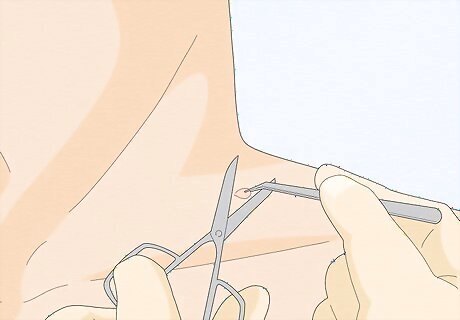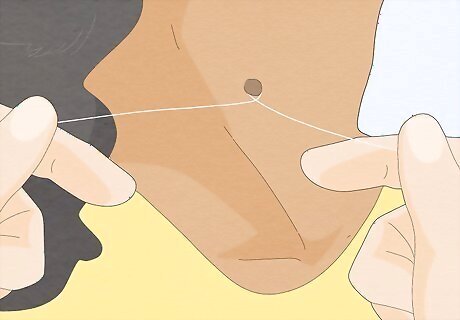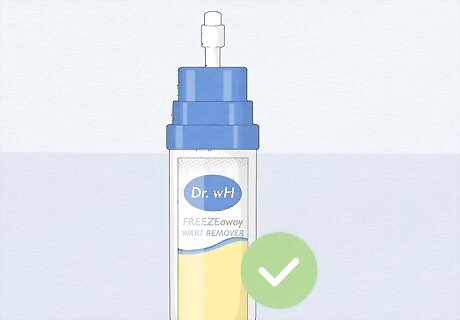
views
X
Trustworthy Source
Harvard Medical School
Harvard Medical School's Educational Site for the Public
Go to source
Confirm that the growth is a skin tag.

Moles, warts, and other skin conditions might look like a skin tag. The concern here is that some of these conditions indicate a more serious risk, including cancer. Even if you're pretty sure that it's a skin tag, only a doctor or dermatologist can tell you for sure. Usually, a doctor only needs to look at the growth to identify it as a skin tag. If they're not sure, they might take a biopsy (a small sample of tissue) and send it to a lab for testing. Never attempt to remove a skin tag without first confirming that it's a skin tag. If it happens to be something else, you can potentially do serious damage to your skin.
Cut off a small, hanging tag with sharp, clean scissors.

Dip scissors and tweezers in rubbing alcohol to disinfect them. Grasp the end of the tag with your clean tweezers and pull it away from your skin, then snip across the base. Have a piece of sterile gauze ready because it will likely bleed a little. Any sharp scissors will work, but small scissors, such as cuticle scissors, tend to work best because you have more control. You usually won't feel more than a pinch when you do this, but if you're worried about it hurting, numb your skin with a piece of ice first. Get a friend to help if you're not sure if you can do it by yourself. Clean the wound with soap and warm water, pat your skin dry, and cover it with a small bandage for a day or so. Small tags are typically only a couple of millimeters (a fraction of an inch) or less in diameter—the size of the point of a sharp crayon. Never try to cut off a larger tag. It'll bleed and might become infected. This also won't work for flat tags that aren't hanging off the surface of your skin.
Tie off the base if you don't want to cut the tag.

Use tweezers to pull the tag away from the skin. Tie a loop of dental floss around the base and pull it tight. You might want to tie a knot to make sure the loop stays tight and in place, then cut off the excess floss and release the tag. A thin piece of thread, like you would use for sewing, can also work. Leave the floss tied around the base of the tag to deprive it of blood. It will turn red, then black, and then it will drop off. Usually, the skin under the tag is already healed at this point. The whole process can take several days, so if the floss or thread happens to come off during that time, simply tie another strand back on.
Try an over-the-counter treatment as an alternative.

Buy over-the-counter skin tag treatments online or at your local pharmacy. If you don't like the idea of cutting or tying off a piece of your skin, one of these tag treatments might be better for you. Most of these products are freezing kits, similar to wart removal kits. They can be effective, but might require more than one application to remove the tag completely. When you don't remove the entire skin tag after a single treatment, you run the risk that it'll come back unless you immediately start a second treatment to remove the rest of it. Keep in mind that since these treatments destroy skin cells, they might damage the skin surrounding the tag and lead to scarring. If you're trying to get rid of the skin tag for cosmetic reasons, you might end up with a bigger issue than you started with.
Avoid home remedies that aren't backed up by science.

Home remedies typically involve some sort of acid that can burn your skin. Home remedies that claim to remove skin tags are all over the internet, typically telling you to put an acidic substance, such as lemon juice or apple cider vinegar, on the skin tag. These remedies can burn your skin and cause scarring. While these remedies might successfully remove your skin tag, they usually end up injuring the surrounding skin in the process. If you're trying to remove the skin tag for cosmetic reasons, you'll likely end up with a bigger problem than you had when you started.
See your doctor for surgical removal.

This is the easiest and safest way to remove a skin tag. Unfortunately, since health insurance doesn't typically cover skin tag removal, it might also be the most expensive option. There are 3 ways your doctor might remove the skin tag, depending on the size of the tag and the condition of the skin around it: Cut it off using a scalpel Freeze it off using liquid nitrogen Burn it off using a laser


















Comments
0 comment